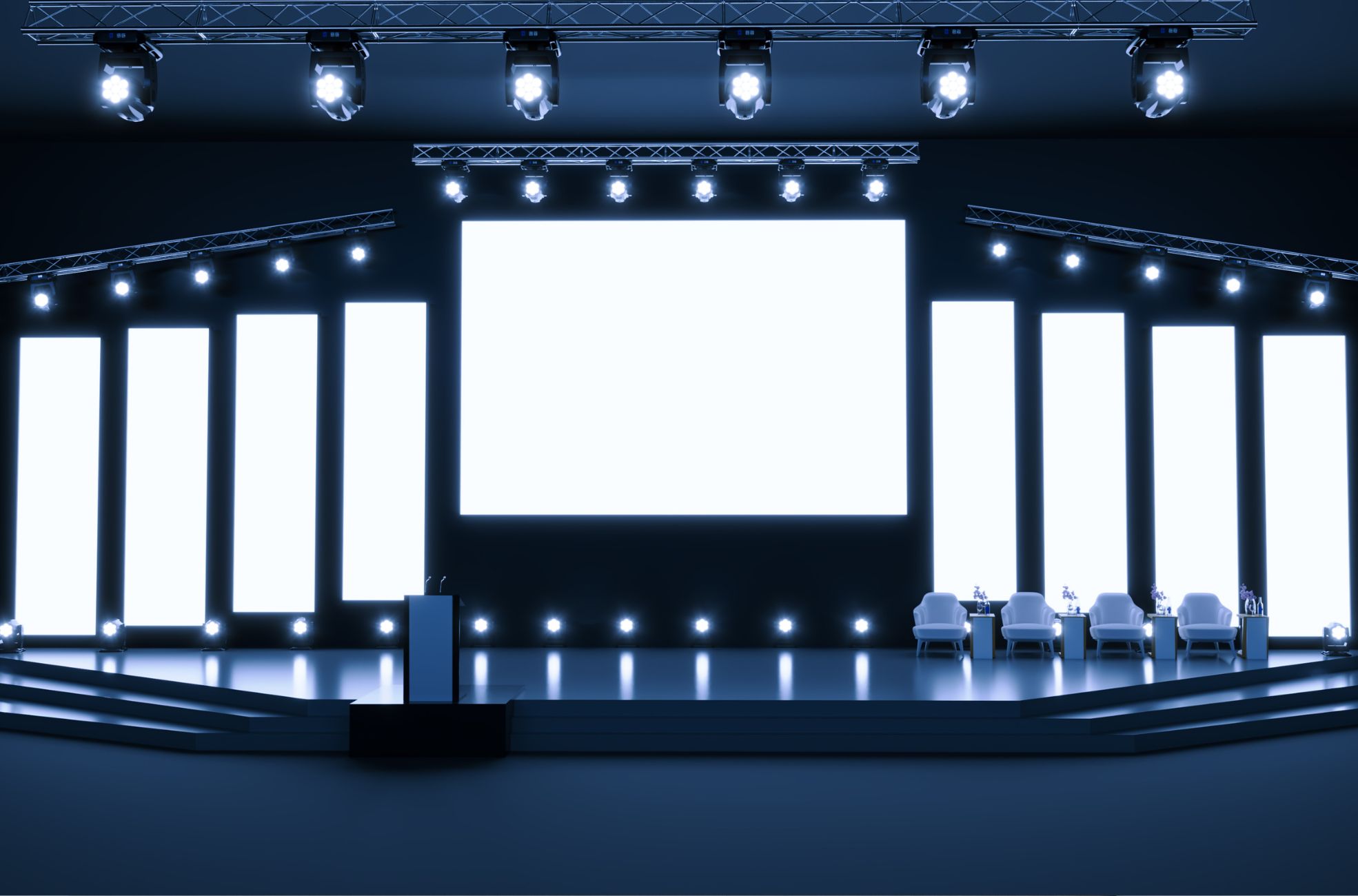Crafting an impactful event stage design is essential in setting the scene and captivating your audience immediately. It’s a dynamic art form that blends aesthetics, technology, and practicality to create unforgettable experiences. As expectations rise and technology offers new possibilities, you’ll find event planners and designers embracing innovative ideas to deliver stages that engage and inspire.
From integrating state-of-the-art LED screens and projection mapping to incorporating sustainable materials and techniques, we explore a range of ingenious designs and strategies. These insights will help you create an environment that resonates with your audience and amplifies the event’s message, ensuring every attendee leaves with a lasting impression.
Embracing Technology in Stage Design
Integrating LED Screens for Visual Impact
The evolution of LED technology has revolutionised stage design. As an event organiser, you now have the tools to create stunning backdrops and dynamic visuals that captivate audiences. LED screens have become essential in conference stage design, offering a canvas tailored to any theme or content.
The flexibility of LED displays allows for the creation of immersive environments that can transform a venue. The emerging trend of 360-degree staging puts the audience at the heart of the action. It surrounds the stage and enhances the feeling of inclusivity.
Projection-Mapping for Immersive Backgrounds
Projection mapping has become a powerful tool to elevate the ambience of an event. It turns ordinary surfaces into extraordinary visual experiences. Event designers can create unique and interactive displays by projecting video and lighting effects onto three-dimensional objects.
This technique is particularly effective when you want to enhance rather than completely alter a space. It adds a layer of depth and engagement to the environment. Projection mapping can serve various purposes, from showcasing sponsor advertisements to creating captivating decor.
Implementing Augmented Reality for Interactive Experiences
Augmented Reality (AR) has shifted from a futuristic concept to a practical element in stage design. AR overlays digital information onto the physical world, creating a blended reality that encourages audience interaction. This technology allows for real-time data, graphics, and interactive elements to be superimposed onto the live environment.
AR offers attendees an immersive experience that goes beyond passive viewing. Its adaptability to different spaces and event formats and its ability to measure and analyse attendee engagement make it a valuable tool. AR creates personalised and memorable experiences.
Advantages of Using Stage Automation
Stage automation represents a significant advancement in event management. It streamlines various aspects of the event lifecycle through technology. Event planners can save time and focus on more critical areas by automating tasks such as proposal compilation, marketing, and client experience management.
Automation also allows for a more efficient handling of demand fluctuations, ensuring profitability and a professional image. Interactive 3D floor plans and automated emails are examples of how automation can enhance the planning process, run sheet and attendee experience. As event technology advances, incorporating tools like artificial intelligence and augmented reality, the potential for creating engaging and immersive events that resonate with audiences is immense.
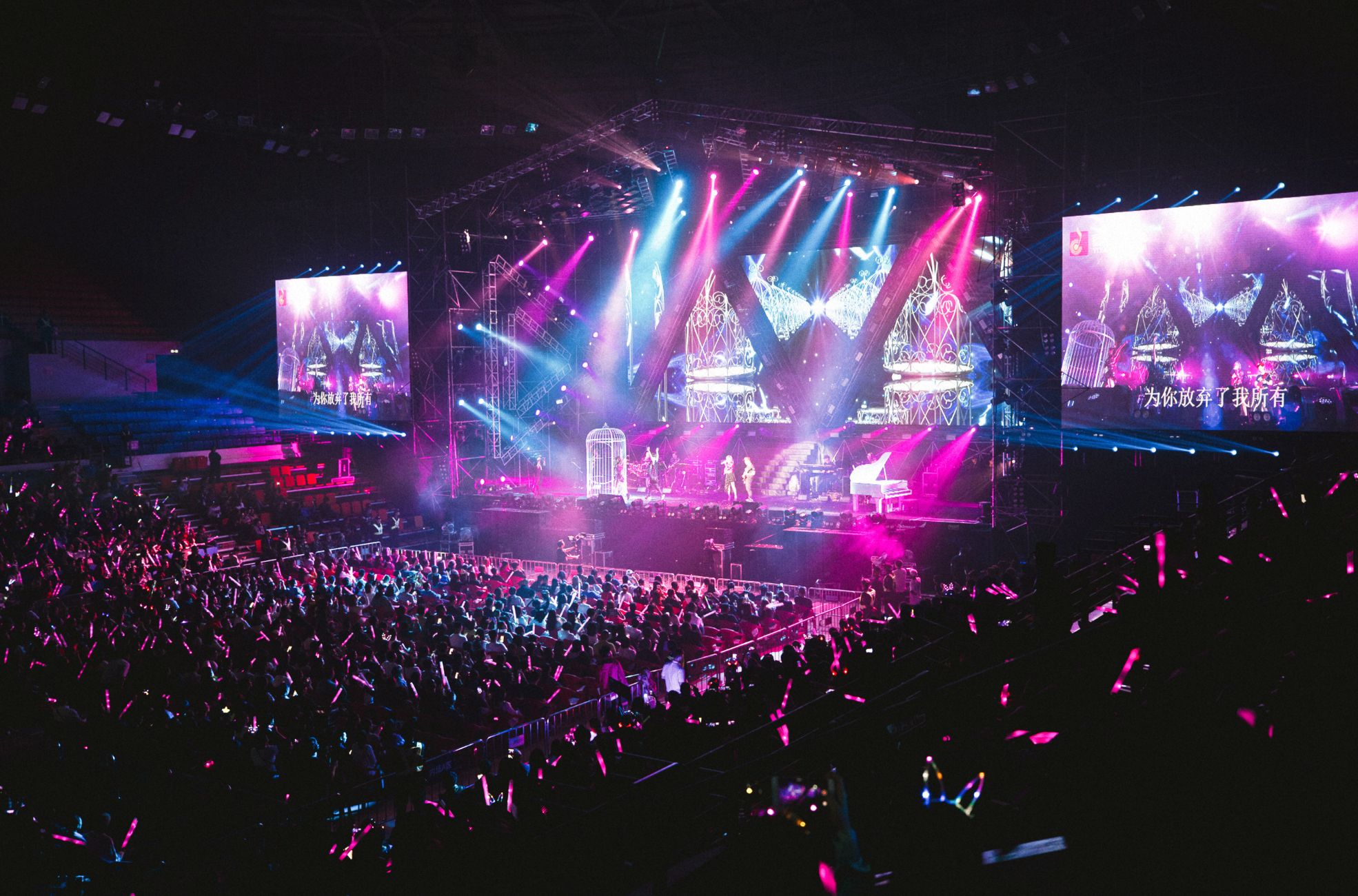
Sustainable Designs in Event Staging
Materials: Choosing Eco-Friendly Options
The selection of materials in event staging is a must in minimising environmental impact. Traditional scenic construction often involves the use of new resources, which can lead to significant ecological damage. To combat this, designers are increasingly turning to sustainable materials that have a reduced carbon footprint over their lifespan.
Opting for wood from sustainably managed forests over synthetic alternatives is a positive step, as it is more likely to decompose without harming the environment. Additionally, the adoption of low-VOC paints is gaining traction, as they release fewer harmful compounds into the atmosphere compared to traditional paints.
Utilising naturally biodegradable materials such as jute, bamboo, or hemp allows designers to reduce their production’s ecological impact significantly.
Energy Efficiency with LED Lighting and Solar Power
Adopting energy-efficient solutions is a vital aspect of eco-friendly event staging. LED lighting is favoured for its low energy consumption and longevity. Moreover, the integration of solar power is becoming increasingly prevalent, particularly for outdoor events.
Portable solar panels provide a clean and silent power source that can be deployed with minimal fuss, eliminating the need for cumbersome wiring. Innovations like the Solar Shuttle, powered solely by solar energy, exemplify the potential for solar technology to replace traditional generators in many scenarios.
Harnessing solar energy enables stages to diminish reliance on fossil fuels and lower their carbon footprint, contributing to a more sustainable event.
Reusable and Modular Stage Elements
Sustainable stage design also involves the strategic use of reusable and modular components. Designers are devising ways to repurpose existing structures or construct new ones from modular elements that can be reconfigured for various events. Such systems allow for diverse stage designs and are convenient to transport and store.
This approach conserves resources and finances and mitigates environmental harm by enabling repeated use of the components. Maintaining an inventory and designing sets for easy disassembly facilitates retaining and repurposing materials for future use rather than discarding them.
Disposal and Recycling Post-Event
Proper disposal and recycling of staging materials post-event are critical for sustainability. Many set pieces traditionally end up in landfills, where they contribute to greenhouse gas emissions due to improper decomposition.
Creating sets that can be easily dismantled ensures that materials are directed towards appropriate reuse or recycling channels. Engaging with local recycling programs and understanding the recyclability of various materials is essential. Additionally, assigning value to repurposed items can highlight both cost savings and environmental benefits.
Efficient planning and inventory management can minimise waste, and any surplus materials should be retained for future use or responsibly recycled, further enhancing the sustainability of event staging.
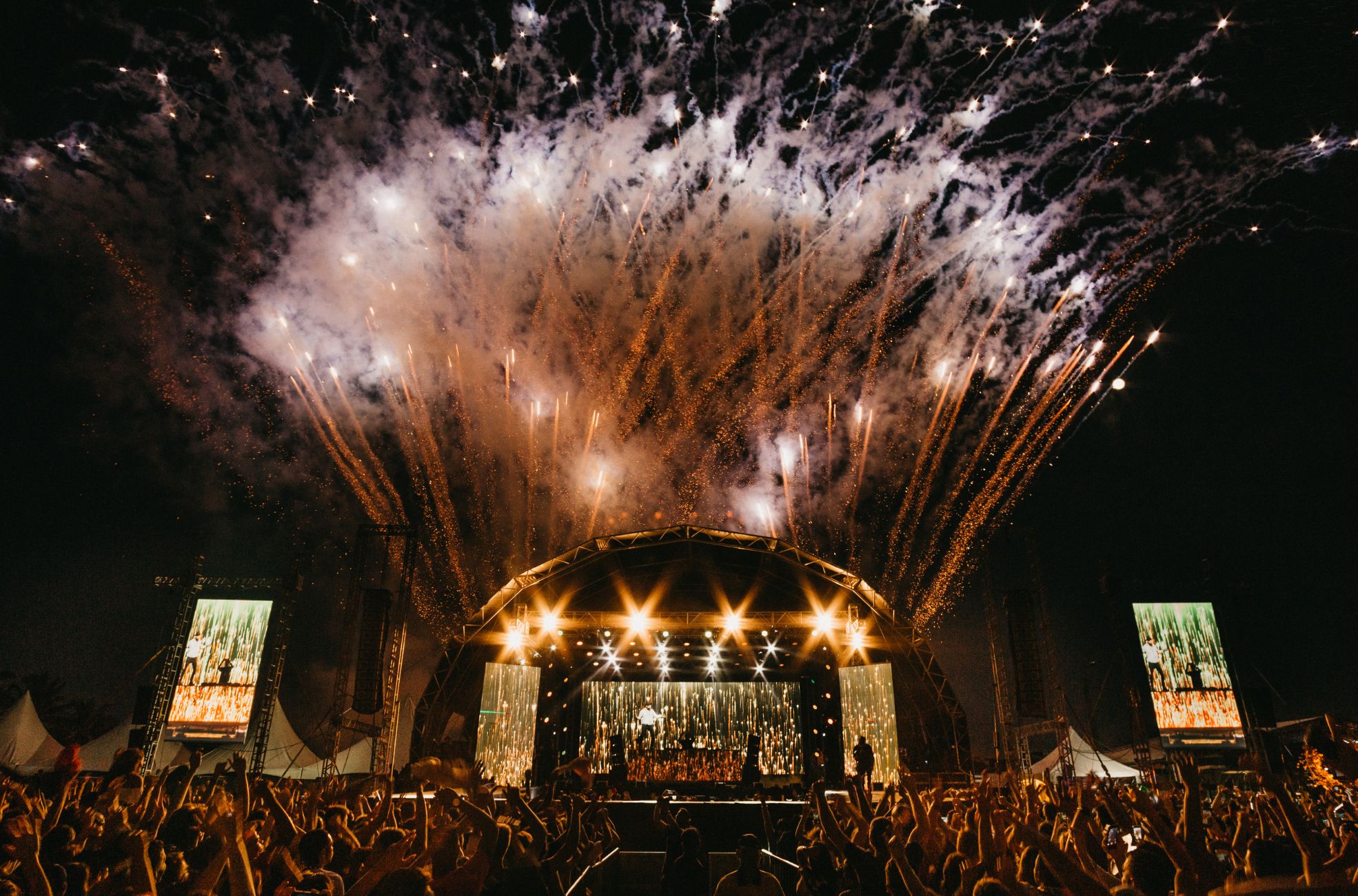
Theme-Centric Stage Concepts
Analysing the Event’s Purpose and Audience
Identifying the event’s core objectives and the audience’s characteristics is crucial. The purpose of the event guides the design direction, whether it’s a thought-provoking Ted Talk, a lavish gala dinner, or a summit addressing critical issues like climate change. Each event type requires a unique approach to stage design that complements the theme and meets the audience’s expectations.
For example, a younger demographic might be drawn to a stage with dynamic lighting such as strobes. At the same time, a more mature crowd may prefer subtler, less distracting elements. Recognising these nuances is essential to creating a stage that looks appealing and enhances the overall experience for attendees.
Theme Integration in Physical Design
After determining the event’s purpose and the audience’s preferences, the next step is to weave the theme into the physical aspects of the stage design. This involves selecting elements such as backdrops, furniture, décor, and lighting, all of which should resonate with the thematic narrative. For instance, a stage adorned with 90,000 Swarovski crystals and futuristic orbs can transport attendees to a world of glamour and innovation, reflecting a theme of unity among movie enthusiasts.
The physical design must create an environment that captivates the audience from the moment the auditorium lights dim and the stage comes to life.
Customisable Elements for Different Themes
Flexibility in stage design is key to customising the experience for various themes. Customisable elements such as screens, lighting, and props allow designers to adapt the stage to fit a wide range of themes, from the sleek and modern to the raw, textured feel of an industrial setting. The use of AR can further enhance this adaptability, offering virtual experiences that break the traditional boundaries of stage design.
By employing a mix of physical and digital elements, designers can create a stage that’s not only versatile but also deeply engaging for both in-person and remote audiences.
Case Studies: Successful Theme-Based Stages
Examining successful theme-based stages provides insights into the effective integration of design principles. For instance, a stage design that extends beyond the physical footprint of the stage and into the audience space can create a more inclusive atmosphere. This approach was exemplified by a design featuring a simple yet stylish backdrop of curved shapes, seamlessly blending with the conference’s colour scheme and style.
Another example is the dual experience created for a major retail client, where in-person and remote audiences enjoyed the event in distinct ways yet felt like active participants in a unified programme. Such case studies highlight the importance of balance, unity, variety, and harmony in stage design. They also show the impact of thoughtful lighting, clear audio, and sharp visuals in delivering a seamless and memorable event experience.
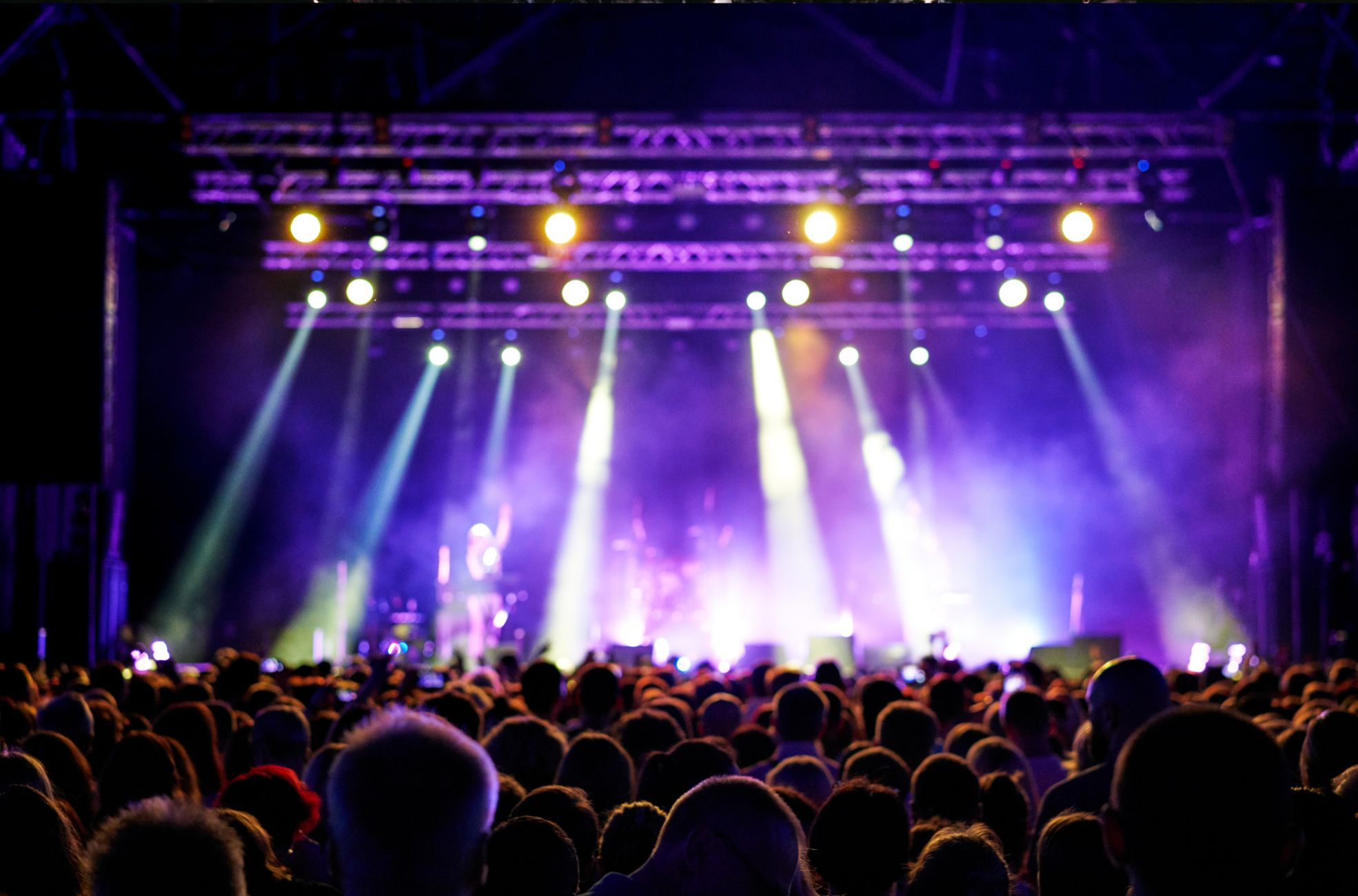
Ensuring Audience Engagement
Configuring Seating for Optimal Viewing
The seating configuration is pivotal in connecting the stage with the audience. The layout should be conducive to the event’s format and attendees’ comfort. Auditorium-style seating is suitable for large audiences and formal presentations but may not be ideal for interactive sessions. Banquet seating encourages networking but may limit collective engagement.
Boardroom seating fosters discussion. It focuses on a central figure suitable for meetings but less so for visual displays. Classroom seating supports learning environments but may lack the professional ambience desired for certain events. Selecting the right seating arrangement ensures that all attendees have an unobstructed view and can fully participate in the event.
Stage Positioning and Layout for Better Interaction
Strategic placement of the stage within the venue establishes a focal point that can enhance audience engagement. Thoughtful stage layouts can provide additional value, such as photogenic backdrops that encourage social sharing. For events accommodating remote participants, incorporating elements that cater to both physical and virtual attendees can create a cohesive experience.
Interactive features for online viewers, such as live polls, can complement the in-person spectacle, ensuring that all attendees feel included and engaged regardless of location.
Audio Visuals: Ensuring Clarity and Reach
High-quality audio-visual equipment is essential to effectively deliver a message to the entire audience. Superior sound systems are necessary to ensure that audio reaches every corner of the venue without distortion. Visual components must be visible from every seating position, utilising large displays and strategic lighting to maintain visibility and focus.
For hybrid events, delivering a seamless virtual experience is as important as the physical one, achieved through dynamic set changes and engaging digital content.
Engaging Senses Beyond Sight and Sound
An event stage that appeals to multiple senses can create a lasting impression. Incorporating elements that engage the sense of touch, smell, or even taste can elevate the attendee experience. For example, environmental staging can transport attendees to a unique setting. At the same time, AR and Virtual Reality (VR) can offer an interactive, multi-sensory journey aligned with the event’s message.
Creating spaces for relaxation and conversation within the venue can also foster networking and complement the event’s theme, ensuring the stage design resonates with the audience on multiple sensory levels.
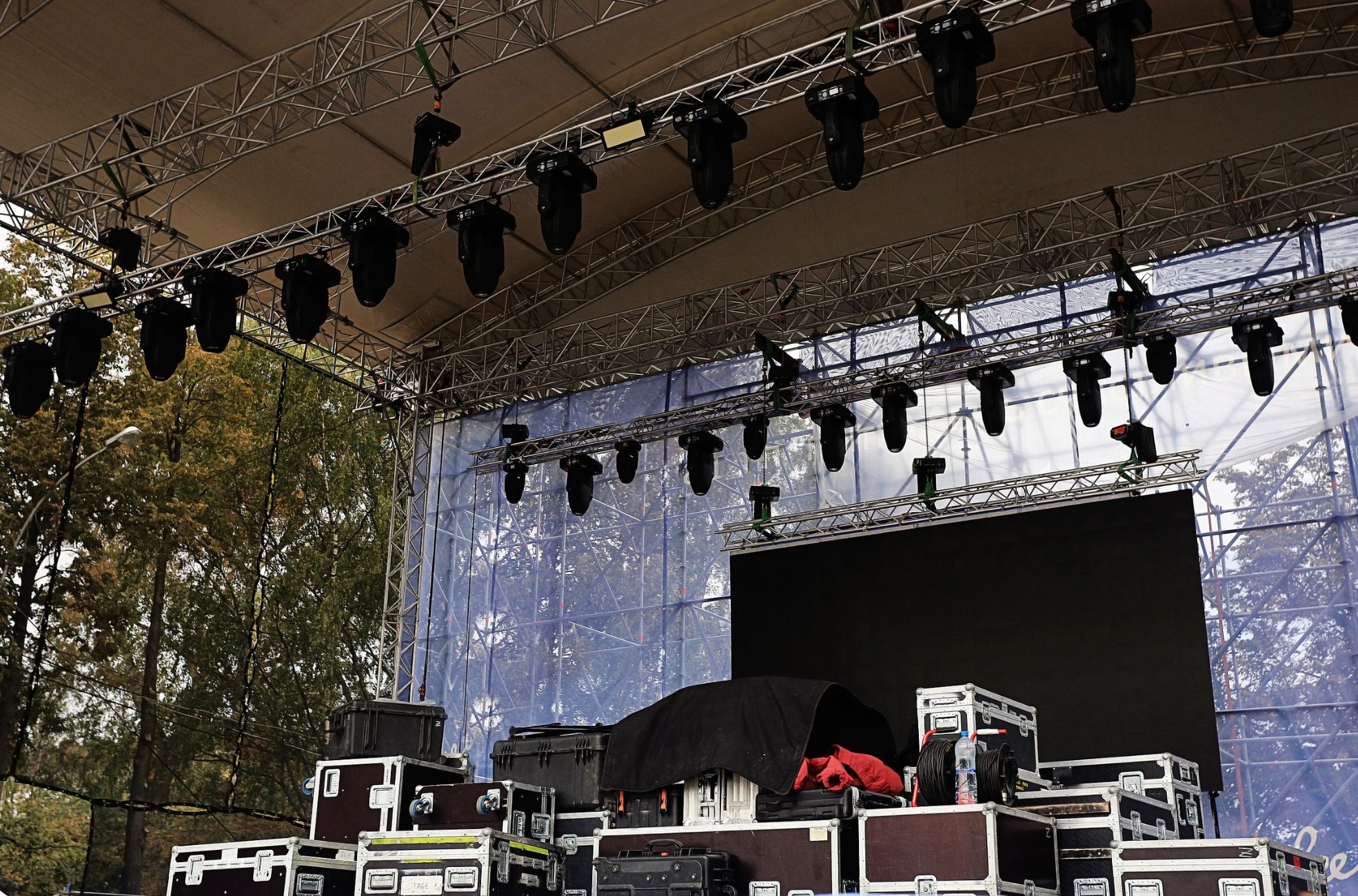
The Role of Lighting in Stage Design
Lighting in stage design isn’t just a functional element to ensure visibility. It’s a powerful tool that shapes the environment, directs your attention, and sets the emotional tone of an event.
The strategic use of lighting can transform a simple stage into a captivating experience, enhancing the storytelling and leaving a lasting impression on you.
Selection of Lighting Equipment
Choosing the right lighting equipment is crucial for achieving the desired effect on stage. Various fixtures, such as ellipsoidal reflector spotlights, parabolic aluminised reflector cans, floodlights, and Cyc lights, each serve a specific purpose. For instance, ellipsoidal reflector spotlights are ideal for front lighting due to their intense and well-defined beam, which can be used to highlight performers or set pieces.
Followspots offer similar benefits but are designed to track moving performers, ensuring they remain in the spotlight. Floodlights and Cyc lights provide broad, even washes of light, perfect for illuminating large areas or backdrops. Strip lights can bathe the stage in a spectrum of colours.
The use of gels and gobos can further modify these lights, adding colour or patterns to the stage to support the theme or mood of the event.
Techniques for Mood and Atmosphere Creation
Lighting is a potent medium for creating mood and atmosphere. By manipulating colours, intensity, and direction, lighting designers can evoke emotions and set the tone for each scene. Cool colours suggest a sombre or mysterious atmosphere, while warm colours can create a sense of excitement or comfort.
The use of monochromatic schemes, complementary colours, or triads can significantly alter the visual impact of a performance. Accent lighting adds depth and dimension, while ambient lighting establishes the overall mood. Spotlights can draw attention to key moments or performers, and wash lighting ensures general illumination.
The direction of lighting is also pivotal. For example, backlights create silhouettes, side lighting reveals textures, and downlighting can add drama.
Synchronising Lights with Performance Elements
To maximise the impact of lighting, it must be in harmony with the performance elements. This requires early and ongoing communication between the lighting designer and the director or event planner. When you understand the performance’s narrative, emotional beats, and key moments, you can plan and execute lighting changes that complement the action on stage.
Modern lighting technology, such as LED lights and programmable systems, offers the flexibility to make quick adjustments and create dynamic effects. Moving lights can introduce an element of surprise and excitement. The careful control of intensity can subtly shift the mood without distracting you.
Safety Considerations with Stage Lighting
While the aesthetic aspects of stage lighting are often the focus, safety considerations are paramount. Professional lighting installers ensure that fixtures are securely attached to trusses or pipes using appropriate clamps. All cabling is run overhead to minimise hazards.
The positioning of lights must take into account both the desired effect and the safety of performers and technicians.
Crafting Memorable Moments
Stage design is not just about building a platform for performance; it’s an art form that plays a crucial role in immersive storytelling. Creative use of technology, sustainability alongside practicality, and a keen understanding of the audience all culminate in crafting a transformative experience. From LED screens that dazzle to AR that bridges the gap between physical and digital realms, each event stage can indeed become a world of its own.
Sustainable practices show respect towards our planet, while adaptable, theme-centric concepts ensure each event feels uniquely engaging. It’s about striking that fine balance between innovation and interaction, creating an ambience that leaves a lasting memory. In every approach, whether through lighting, sound, or design, your stage is the canvas upon which memorable moments are painted. Let’s make each one a masterpiece.

